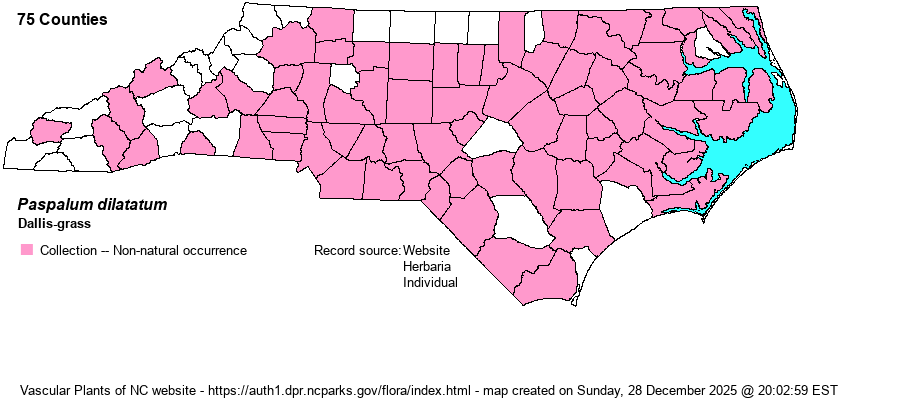| Author | Poiret | |
| Distribution | Throughout the state; no doubt in every county.
Native of South America; in N.A. in the southern U.S. north to OR, OK, MO, and MD. | |
| Abundance | Common throughout the Coastal Plain and Piedmont, uncommon in the Mountains. | |
| Habitat | Dry to moist roadsides, fields, meadows, clearings, disturbed ground. | |
| Phenology | Flowering and fruiting May-November. | |
| Identification | Dallis-grass is a familiar roadside/field/pasture weed and is one of the few in the genus with long-hairy spikelets. P. urvillei also has hairy spikelets, but that species is taller and has 10-30 inflorescence branches (vs. 2-7 such branches in P. dilatatum). | |
| Taxonomic Comments | Paspalum is a genus of more than 300 species, found mostly in the New World. The genus is quite easily identified by the neat row of spikelets along each side of a flattened rachis (inflorescence branch), and also by the hemispherical outline of each spikelet. In some species there are only 2 such inflorescence branches, paired at the stem summit; in most of our species there are 3-4 branches; and in a few there may be many. Keys ask whether spikelets are paired or not -- that is, at each node on each side of the rachis there are pairs of spikelets on tiny stalklets. Care must be taken with a hand lens to make sure there are 2 stalklets at each node, as frequently one of the two spikelets will not grow. Non-paired or single spikelets will clearly have only a single stalklet per node. | |
| Other Common Name(s) | | |
| State Rank | SE | |
| Global Rank | GNR | |
| State Status | | |
| US Status | | |
| USACE-agcp | FAC link |
| USACE-emp | FAC link |

